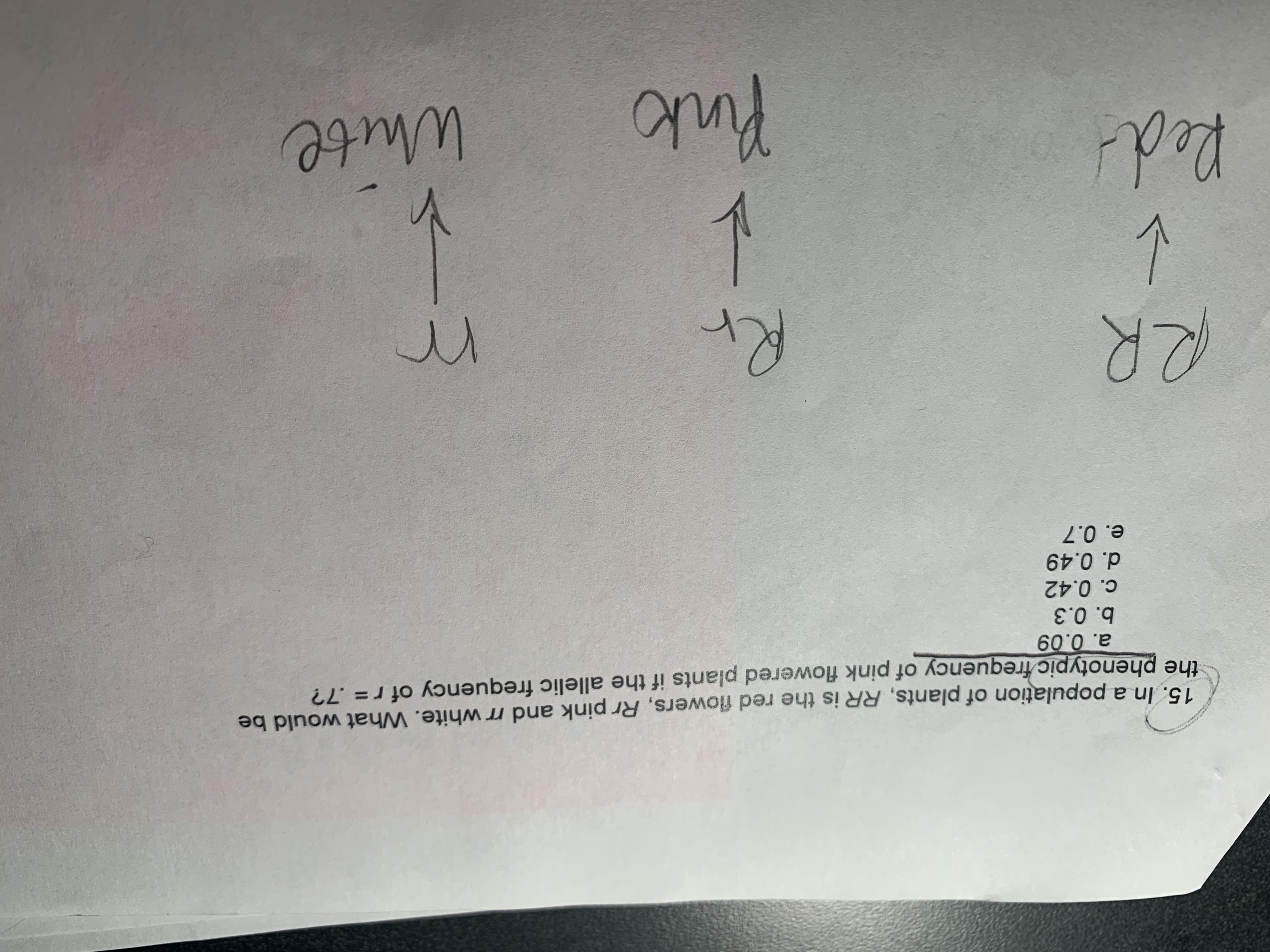
Human Anatomy & Physiology (11th Edition)
11th Edition
ISBN: 9780134580999
Author: Elaine N. Marieb, Katja N. Hoehn
Publisher: PEARSON
expand_more
expand_more
format_list_bulleted
Question
Im having a hard time figuring out how to calculate this using the allele frequency. I know that r+R= 1 but which would make R=.3 but that is not the answer. How fo I calculate this?

Transcribed Image Text:-3
15. In a population of plants, RR is the red flowers, Rr pink and rr white. What would be
the phenotypic frequency of pink flowered plants if the allelic frequency of r= .7?
a. 0.09
b. 0.3
c. 0.42
d. 0.49
e. 0.7
RR
1
Pinko
White
Expert Solution
This question has been solved!
Explore an expertly crafted, step-by-step solution for a thorough understanding of key concepts.
This is a popular solution
Trending nowThis is a popular solution!
Step by stepSolved in 2 steps

Knowledge Booster
Learn more about
Need a deep-dive on the concept behind this application? Look no further. Learn more about this topic, biology and related others by exploring similar questions and additional content below.Similar questions
- Please SHOW YOUR WROK DRAW IF YOU NEED TOO.arrow_forwardK M N P Q R 4. In another one of Mendel's experiments, he crossed the offspring. Two pea plants with purple flowers (Pp) were crossed. ea Purple Flowers P p Phenotype Probability (%) Purple Flowers: White Flowers: 6. In corn nlants, normal height (H) is dominant over short height (h). Complete a Explore EE US 12:4 Purple Flowersarrow_forwardPlease if you don’t know the answer just leave it , I don’t need from google or different websites.arrow_forward
- How would I solve this?arrow_forwardWhich of the postulates was not based on the results that all members of p1 generation are homozygousarrow_forwardnon OBYTOT SEI deutet bos nuol 3. Based on the total number of kernels of corn you counted, calculate the expected number for each phenotype if the parents of this corn were both RrTt. Show how you calculate these numbers below and en transfer them to the observation table (155 Kernels) then INO 4 4. Using chi-square analysis to compare the actual phenotype and expected phenotype numbers determine if you can statistically accept that both parents have the genotype RrTt. Your chi square data will be recorded to helow. nb number) which allows forarrow_forward
- A corn geneticist wants to obtain a corn plant that hasthe three dominant phenotypes: anthocyanin (A), longtassels (L), and dwarf plant (D). In her collection ofpure lines, the only lines that bear these alleles are AALL dd and aa ll DD. She also has the fully recessive lineaa ll dd. She decides to intercross the first two and testcross the resulting hybrid to obtain in the progeny aplant of the desired phenotype (which would have to beAa Ll Dd in this case). She knows that the three genesare linked in the order written, that the distance between the A/a and the L/l loci is 16 m.u., and that thedistance between the L/l and the D/d loci is 24 m.u.a. Draw a diagram of the chromosomes of the parents,the hybrid, and the tester.b. Draw a diagram of the crossover(s) necessary toproduce the desired genotype.c. What percentage of the testcross progeny will be ofthe phenotype that she needs?d. What assumptions did you make (if any)?arrow_forwardMendel crossed a plant with yellow seeds (YY) with a plant with green seeds (yy). The F2 generation yielded 12 200 yellow-seeded plants and 4150 green-seeded plants. From this experiment Mendel proposed the Law of O Segregation O Mutation O Independent assortment O Codominancearrow_forward
arrow_back_ios
arrow_forward_ios
Recommended textbooks for you
 Human Anatomy & Physiology (11th Edition)BiologyISBN:9780134580999Author:Elaine N. Marieb, Katja N. HoehnPublisher:PEARSON
Human Anatomy & Physiology (11th Edition)BiologyISBN:9780134580999Author:Elaine N. Marieb, Katja N. HoehnPublisher:PEARSON Biology 2eBiologyISBN:9781947172517Author:Matthew Douglas, Jung Choi, Mary Ann ClarkPublisher:OpenStax
Biology 2eBiologyISBN:9781947172517Author:Matthew Douglas, Jung Choi, Mary Ann ClarkPublisher:OpenStax Anatomy & PhysiologyBiologyISBN:9781259398629Author:McKinley, Michael P., O'loughlin, Valerie Dean, Bidle, Theresa StouterPublisher:Mcgraw Hill Education,
Anatomy & PhysiologyBiologyISBN:9781259398629Author:McKinley, Michael P., O'loughlin, Valerie Dean, Bidle, Theresa StouterPublisher:Mcgraw Hill Education, Molecular Biology of the Cell (Sixth Edition)BiologyISBN:9780815344322Author:Bruce Alberts, Alexander D. Johnson, Julian Lewis, David Morgan, Martin Raff, Keith Roberts, Peter WalterPublisher:W. W. Norton & Company
Molecular Biology of the Cell (Sixth Edition)BiologyISBN:9780815344322Author:Bruce Alberts, Alexander D. Johnson, Julian Lewis, David Morgan, Martin Raff, Keith Roberts, Peter WalterPublisher:W. W. Norton & Company Laboratory Manual For Human Anatomy & PhysiologyBiologyISBN:9781260159363Author:Martin, Terry R., Prentice-craver, CynthiaPublisher:McGraw-Hill Publishing Co.
Laboratory Manual For Human Anatomy & PhysiologyBiologyISBN:9781260159363Author:Martin, Terry R., Prentice-craver, CynthiaPublisher:McGraw-Hill Publishing Co. Inquiry Into Life (16th Edition)BiologyISBN:9781260231700Author:Sylvia S. Mader, Michael WindelspechtPublisher:McGraw Hill Education
Inquiry Into Life (16th Edition)BiologyISBN:9781260231700Author:Sylvia S. Mader, Michael WindelspechtPublisher:McGraw Hill Education

Human Anatomy & Physiology (11th Edition)
Biology
ISBN:9780134580999
Author:Elaine N. Marieb, Katja N. Hoehn
Publisher:PEARSON

Biology 2e
Biology
ISBN:9781947172517
Author:Matthew Douglas, Jung Choi, Mary Ann Clark
Publisher:OpenStax

Anatomy & Physiology
Biology
ISBN:9781259398629
Author:McKinley, Michael P., O'loughlin, Valerie Dean, Bidle, Theresa Stouter
Publisher:Mcgraw Hill Education,

Molecular Biology of the Cell (Sixth Edition)
Biology
ISBN:9780815344322
Author:Bruce Alberts, Alexander D. Johnson, Julian Lewis, David Morgan, Martin Raff, Keith Roberts, Peter Walter
Publisher:W. W. Norton & Company

Laboratory Manual For Human Anatomy & Physiology
Biology
ISBN:9781260159363
Author:Martin, Terry R., Prentice-craver, Cynthia
Publisher:McGraw-Hill Publishing Co.

Inquiry Into Life (16th Edition)
Biology
ISBN:9781260231700
Author:Sylvia S. Mader, Michael Windelspecht
Publisher:McGraw Hill Education